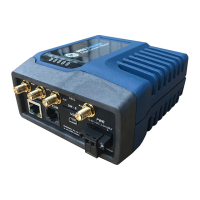MDS 05-6632A01, Rev. F MDS Orbit MCR/ECR Technical Manual 329
% set routing static-routes ipv4 route 2 preference 20
Use Case#2 High Reliability MCR AP to REMOTE Layer-3 Network
Following figure shows a setup to achieve a high reliability network communications between an MCR
AP and REMOTE using 900 MHz and Cellular communications in a redundant layer-3 network setup
using routing functionality.
CELL
NX
ETH
GRE-TUN
ROUTER FUNCTION
Cellular Network
RTU
CELL
NX
ETH
GRE-TUN
ROUTER FUNCTION
RTU
10.10.6.0/24
10.10.7.0/24
REMOTE-1
REMOTE-2
NX configured as routed interface (i.e. out of
the bridge) in 192.168.1.0/24 network.
Cell configured with APN that provides static IP
address.
GRE configured as routed interface over Cell
(Optional) IPsec configured over Cell to provide
security.
Static routes configured for AP:
10.10.1.0/24 -> NX (primary)
10.10.1.0/24 -> GRE-TUN (backup)
Failover enabled by checking primary route’s
reachability by pinging AP’s NX interface or by
monitoring NX link status.
NX configured as routed interface (i.e. out of
the bridge) in 192.168.0.0/16 network.
Cell configured with APN that provides static IP
address.
GRE configured as routed interface over Cell
(Optional) IPsec configured over Cell to provide
security.
Static routes configured for REMOTE#1:
10.10.6.0/24 -> NX (primary)
10.10.6.0/24 -> GRE-TUN (backup)
Static routes configured for REMOTE#2:
10.10.7.0/24 -> NX (primary)
10.10.7.0/24 -> GRE-TUN (backup)
Failover to Cell enabled by checking primary
route’s reachability by pinging remote’s NX
interface.
CELLNX
ETH
GRE-TUN
ROUTER FUNCTION
RTU
AP
10.10.1.0/24
MCR to MCR NX+CELL redundant network (layer-3) setup using routing – Use case#2
Figure 3-227. MCR to MCR NX+CELL redundant network (layer-3) setup using routing
In above use case, a remote asset (e.g. RTU) connected to AP can send/receive data to/from another
remote asset connected to a REMOTE. Both, AP and REMOTE MCR have 900 MHz radio (NX) and
Cellular radio options. The NX interface is configured as a routed interface (i.e. outside of the Bridge).
All REMOTEs have non-overlapping LAN subnet configuration. The IP packets sent by remote asset
connected to AP are normally routed by the AP towards the REMOTE over the NX interface. The IP
packets sent by remote asset connected to REMOTE are normally routed by the REMOTE towards the
AP over the NX interface. Both AP and REMOTE verify the primary link (NX) connectivity by sending
periodic ICMP echo requests (pings). In the event that N (configurable) successive pings are lost, both AP
and REMOTE update their routing tables to direct traffic over cellular network instead. Both still keep
checking the primary link connectivity. Once primary link connectivity is restored (i.e. N successful
pings), both AP and REMOTE update their routing tables to direct traffic over NX network.
The above setup is facilitated by same functionality as described in previous section.

